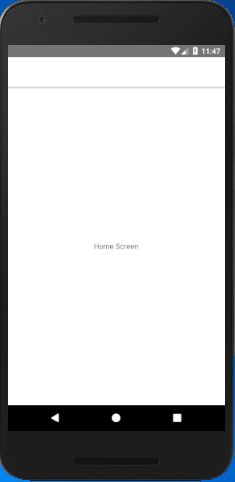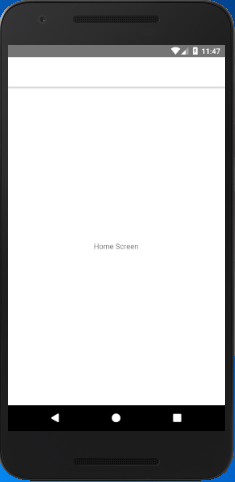React Native Tutorial
- React Native Tutorial
- React Native Environment Setups
- React Native First Application Hello World
- React Native View
- React Native State
- React Native Props
- React Native Style
- React Native Height and Width
- React Native Button
- React Native Layout and Flexbox
- React Native Positioning Element with Flex
- React Native ScrollView
- React Native ListView
- React Native FlatList
- React Native SectionList
- React Native Touchables
- React Native Text Input
- React Native ActivityIndicator
- React Native Picker
- React Native StatusBar
- React Native Switch
- React Native WebView
- React Native ProgressBarAndroid
- React Native ProgressBar With Animated
Navigation
- React Native Navigation
- React Native Configuring Header Bar
- React Native Moving Between Screens
- React Native Passing Value between Screen
- React Native Tab Navigation
- React Native Adding Icons at the Bottom of Tab Navigation
- React Native Create Material Bottom Tab Navigator
- React Native Top Tab Navigator
- React Native Drawer Navigation
Storage
React Misc
- React Native Google Map
- React Native Modal
- React Native Vector Icons
- React Native Splash Screen
- React Native vs. Ionic
- React Native vs. Xamarin
- React Native vs Flutter
- React Native vs React
- React Native vs Swift
- Box shadow in React Native
- React Native IAP
- React-Native Localization
- React Native Toast
- React Native Sound
React Native Navigation
React Native Navigation is used for managing the presentation, and transition between multiple screens. There are two types of navigation built in mobile applications. These are stack navigation and tabbed navigation patterns.
React Navigation Installation
React Navigation is generated from React Native community that provides the navigation solution written in JavaScript.
Create the React Native project and install the required packages and dependencies.
Install the react-navigation package in React Native project using any one of the below command.
# or with npm
# npm install --save react-navigation
After successful execution of the above command, it adds the "react-navigation": "^3.3.0" (3.3.0 is version) in package.json file.
After that, install react-native-gesture-handler package.
# or with npm
# npm install --save react-native-gesture-handler
Now, link all the native dependencies together using command:
To complete the installation of 'react-native-gesture-handler' for Android, make the following modification in MainActivity.java.
projectDirectory/android/app/src/main/java/com/project/MainActivity.java
import com.facebook.react.ReactRootView;
import com.swmansion.gesturehandler.react.RNGestureHandlerEnabledRootView;
. . .
@Override
protected ReactActivityDelegate createReactActivityDelegate() {
return new ReactActivityDelegate(this, getMainComponentName()) {
@Override
protected ReactRootView createRootView() {
return new RNGestureHandlerEnabledRootView(MainActivity.this);
}
};
}
Creating a stack navigator
To create a stack navigation, we import createStackNavigator and createAppContainer functions of react-navigation library.
App.js
import {Button, View, Text } from "react-native";
import { createStackNavigator, createAppContainer } from "react-navigation";
class HomeScreen extends React.Component {
render() {
return (
<View style={{ flex: 1, alignItems: "center", justifyContent: "center" }}>
<Text>Home Screen</Text>
</View>
);
}
}
const AppNavigator = createStackNavigator({
Home: {
screen: HomeScreen
}
});
export default createAppContainer(AppNavigator);
The createStackNavigator is a function which takes a route configuration object and options object. It returns the React component.
MainActivity.java
import com.facebook.react.ReactActivity;
import com.facebook.react.ReactActivityDelegate;
import com.facebook.react.ReactRootView;
import com.swmansion.gesturehandler.react.RNGestureHandlerEnabledRootView;
public class MainActivity extends ReactActivity {
@Override
protected String getMainComponentName() {
return "naviExe";
}
@Override
protected ReactActivityDelegate createReactActivityDelegate() {
return new ReactActivityDelegate(this, getMainComponentName()) {
@Override
protected ReactRootView createRootView() {
return new RNGestureHandlerEnabledRootView(MainActivity.this);
}
};
}
}
When we run the above code, we see an empty navigation bar containing the HomeScreen component.
Output:

Shorthand route configuration
When we have only a single screen as route that is Home screen component, we do not need to use the {screen: HomeScreen} , we can directly use the home component.
Home: HomeScreen
});
Adding title and styling navigation
title: 'Home',
headerStyle: {
backgroundColor: '#f4511e',
},
headerTintColor: '#0ff',
headerTitleStyle: {
fontWeight: 'bold',
},
};
import { View, Text } from 'react-native';
import { createStackNavigator, createAppContainer } from 'react-navigation';
class HomeScreen extends React.Component {
static navigationOptions = {
title: 'Home',
headerStyle: {
backgroundColor: '#f4511e',
},
// headerTintColor: '#0ff',
headerTitleStyle: {
fontWeight: 'bold',
},
};
render() {
return (
<View style={{ flex: 1, alignItems: 'center', justifyContent: 'center' }}>
<Text>Home Screen</Text>
</View>
);
}
}
const AppNavigator = createStackNavigator({
Home: HomeScreen
});
export default createAppContainer(AppNavigator);
Adding a second route screen
Create another class (ProfileScreen) in App.js file to add the second route screen to the stack navigator.
render() {
return (
<View style={{ flex: 1, alignItems: "center", justifyContent: "center" }}>
<Text>Details Screen</Text>
</View>
);
}
}
const AppNavigator = createStackNavigator(
{
Home: HomeScreen,
Profile: ProfileScreen
},
{
initialRouteName: "Home"
}
);
The initialRouteName options object specifies the initial route in the stack navigation.
Complete code:
App.js
import { View, Text } from 'react-native';
import { createStackNavigator, createAppContainer } from 'react-navigation';
class HomeScreen extends React.Component {
render() {
return (
<View style={{ flex: 1, alignItems: 'center', justifyContent: 'center' }}>
<Text>Home Screen</Text>
</View>
);
}
}
class ProfileScreen extends React.Component {
render() {
return (
<View style={{ flex: 1, alignItems: "center", justifyContent: "center" }}>
<Text>Details Screen</Text>
</View>
);
}
}
const AppNavigator = createStackNavigator(
{
Home: HomeScreen,
Profile: ProfileScreen
},
{
initialRouteName: "Home"
}
);
export default createAppContainer(AppNavigator);
Output:

In the next section, we will learn how to go from Home route to Profile route (one screen to another).


